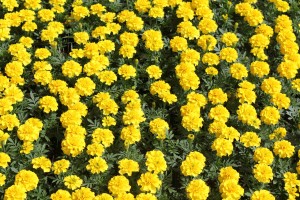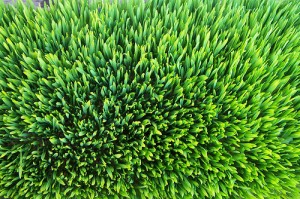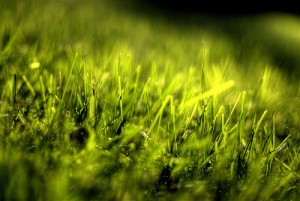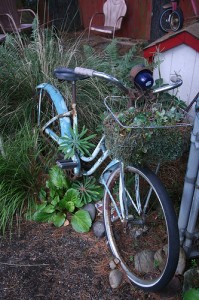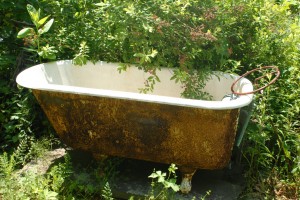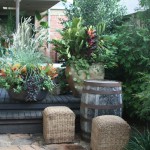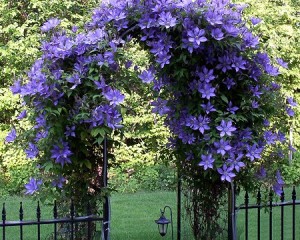
Vibrant Clematis adds mystery to this garden arbor!
Look, up in the sky! It’s a bird, it’s a plane, it’s a… climbing Clematis on a trellis! What a lovely site! Roses, Clematis, wisteria, annual morning glories, jasmine, grape vines and ivy of all shapes winding their way upwards – stretching toward the heavens to add beauty and privacy to your home!
Do you have a patio that could use a little more shade in the afternoon, or wall of color to obscure the neighbor’s driveway? Would you like to create a little get-away in the back yard for that late afternoon reading time? How about creating movable bursts of color to punctuate your garden? Having a high-rise wall of foliage can create mystery in the yard or garden by allowing the visitor to your garden a sense of adventure and intrigue. By introducing vertical elements into your garden, you build a mild suspense. What is on the other side of that dense green tapestry?
Climbing gardens are nothing new, dating back to at least the 18th Century when traditional European gardeners used Treillage to punctuate their areas with wooden structures where plant life wove itself into the inviting openings of the architecture. These movable structures can be a great addition today as well in your Earthen Garden!
In order for plants to climb, they need a structure to cling to. Perhaps the most popular structure for plants to climb is a simple trellis. This usually consists of thin pieces of wood, metal or plastic brought together in a criss-cross pattern. Depending upon how creative you are, your trellis can take on attributes that make it an elaborate work of art!
You may choose to buy a pre-made trellis like these:













or make you own. Here is a pre-made Garden and Bench/Trellis plan that’s sure to fit your budget, and make you look like a ‘trellis titan’, if you’re a little shaky about designing one yourself.


A simple treillage obelisk structure can be made by building three triangular wooden frames out of pine wood, or whatever 1X2 or 2X2 wood you happen to have; and covering the area with a sub straight for the plant to attach itself to. This sub straight can be wooden or plastic lattice purchased from a store and cut to size, or a screen material (like Duramesh® PVC Coated Hex Wire 1′ x 150′ – Growers Supply), or chicken wire stapled to the wooden frame.
After completing the construction, lean the three frames together to form a point at the top (think tall pyramid), and secure them together with wire, string or wire ties (plastic straps that ratchet as they close in a ‘one-way’ fashion). There you have it, a treillage obelisk! Don’t be too concerned if the initial structure seems a bit unsteady or unsightly, the strength of the piece will increase as the planting grows and intertwines with the structure, and your construction – however crude or elaborate – will soon disappear behind a living wall of beauty!
Items you may need for a do-it-yourself project:
• A quantity of 1X2 or 2X2 or 2X4 wood (depending upon the size of the project)
• Staples, nails or wire
• Stapler, stapler gun
• Lattice, wide mesh screen or chicken wire
• Plant material
Selecting the plant material is a matter of choice based upon your personal color choice, and plant likes and dislikes. As mentioned above some of the varieties include:
• Roses
• Clematis
• Wisteria
• Annual morning glories
• Jasmine
• Grape vines
• Ivy (Boston ivy, Virginia Creeper)
• Trumpet vine
• Black-Eyed Susan vine
• Climbing Snapdragon
Placing your Treillage facing south will give the best sunlight for maximum growth during the growing season, but it may not give you the desired effect you had in mind. Many gardeners find the idea of concealment to be the prime motivator in a climbing garden, and the area they want to conceal may not always be facing south. That’s not a problem. Choose the area you feel will have the greatest impact in your yard or garden, and begin building and planting!
As spring turns into summer, your climbing gardens will turn into unique lush works of art that will add, excitement, form and a sense of mystery to your Earthen Garden!





